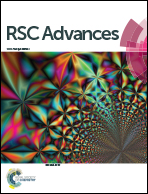Efficient antibacterial activity via protein degradation of a 3D layered double hydroxide–reduced graphene oxide nanohybrid†
Abstract
Graphene and its derivatives have typical physicochemical properties that show strong cytotoxic effects on bacterial cell lines. In this study, we have investigated the antibacterial activity of a nanohybrid of three-dimensional Mg–Al layered double hydroxide–reduced graphene oxide (LDH–rGO) on the Gram negative coccobacilli bacterium Escherichia coli (E. coli). A biocompatibility test by a sulphorhodamine-B (SRB) assay inferred that LDH–rGO is biocompatible up to a concentration of 2 mg mL−1. The concentration and time-dependent antibacterial studies confirmed that 125 μg mL−1 of LDH–rGO is sufficient to inhibit 95.4 ± 1.1% E. coli cells in 60 min. A systematic study shows that the nanohybrid is capable of developing oxidative stress by producing reactive oxygen species (ROS), while LDH and rGO does not. However, both rGO and the nanohybrid are capable of developing oxidative stress by oxidizing glutathione. Further, the effect of oxidative stress on one of the biological entities (protein) of E. coli was also studied. We thereby propose the antibacterial mechanism of the nanohybrid on the basis of size, morphology, glutathione loss, and protein degradation.


 Please wait while we load your content...
Please wait while we load your content...